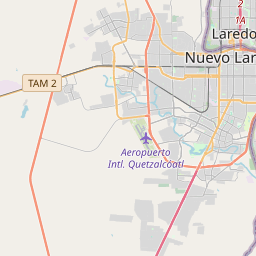Juan Francisco Farías Residence







Soldier and Laredo alcalde Jose Andres Farias and his wife Guadalupe Sanchez married at San Agustin Church in 1803 and had seven children; the oldest, Juan Francisco Manuel de la Trinidad Farias, was born in January 1807. He followed the family tradition of civic duty, serving as alderman and mayor of Laredo. Juan Francisco was also named secretary to the Republic of the Rio Grande, formed in Laredo in January 1840. Juan Francisco married Maria de los Inocentes Benavides on June 15, 1832. His bride was a widow born in Parras, Coahuila in December 1810. Juan Francisco and Inocentes had eleven children. Family oral tradition states that their home on this site dates from July 1840. The earliest historical reference is an 1864 deed when the property, along with a stone building and water well, was sold by Juan Francisco Farias to his daughter, Encarnacion Farias de Herrera. The builder of the Farias residence is unknown. The modified rectangular plan house is built of locally fabricated brick clad with stucco. Rooms directly access the exterior, facing the street or patio area. The house has two-foot wide walls of brick and stone along with four fireplaces. A projecting cornice features distinctive rectangular, tooled stone projections, with similar craftsmanship seen on the lintels. Truncated Corinthian wooden columns support the south entrance porch. The site historically included stables and a cart house, water well and cistern. During the Civil War many strategic planning meetings were held in the house. Colonel Santos Benavides and select members of the Benavides Regiment along with then-mayor Juan Francisco Farias planned for the defense of Laredo against the Union Army. Five generations of the Farias family lived here continuously until 1974. Recorded Texas Historic Landmark - 2009
As one of the most visible programs of the Texas Historical Commission (THC), historical markers commemorate diverse topics in Texas history, including: the history and architecture of houses, commercial and public buildings, religious congregations, and military sites; events that changed the course of local and state history; and individuals who have made lasting contributions to the state, community organizations, and businesses.
More history nearby
Texas was once a part of Mexico but gained independence in 1836 after a famous battle at the Alamo.
During the 19th century, Webb County played a crucial role in the struggle for Mexican independence and the subsequent development of the Texas Republic. In 1836, during the Texas Revolution, Mexican troops led by General José de Urrea were defeated by the Texian forces at the Battle of San Patricio, which took place near present-day San Patricio, a community within Webb County.
Following the Texas Revolution, Laredo became an important trading center, connecting the United States and Mexico. The city's location along the Rio Grande made it a key point for trade and transportation, leading to its rapid growth. In 1848, the Treaty of Guadalupe Hidalgo ended the Mexican-American War, and Laredo became part of the United States.
The late 19th and early 20th centuries brought significant changes to Webb County. The arrival of the railroad in the 1880s further stimulated economic growth, as it provided an efficient means of importing goods and exporting local agricultural products. This led to the expansion of ranching and agriculture industries in the region. Additionally, the discovery of oil and gas reserves in the early 20th century brought further prosperity and development to the county.
Today, Webb County continues to thrive as a bustling border city and a hub of trade between the United States and Mexico. With a rich cultural heritage and a vibrant economy, the county serves as an important intersection of history, commerce, and diversity in Texas.
Webb County Timeline
This timeline provides a glimpse into the major events and milestones that have shaped the history of Webb County, Texas.
- 1848 - Webb County is established as a county in the state of Texas.
- 1849 - The first permanent settlers arrive in what is now known as Laredo, the county seat of Webb County.
- 1852 - The county's first courthouse is built in Laredo.
- 1860 - The population of Webb County reaches over 4,000 residents.
- 1881 - The Texas-Mexican Railway reaches Laredo, leading to increased trade and development in the county.
- 1906 - A new courthouse is built in Laredo to replace the previous one.
- 1944 - The Laredo Air Force Base is established, contributing to the county's economy and providing employment opportunities.
- 1977 - The Rio Grande Industrial Park is opened, promoting industrial development in Webb County.
- 2010 - Webb County's population exceeds 250,000 residents.